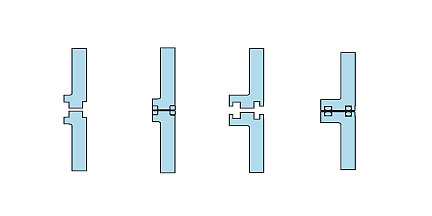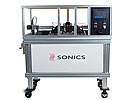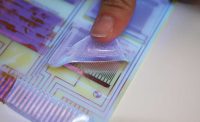Hot-plate welding is one of the simplest and most versatile methods for joining two plastic parts. The technology can weld small parts or large ones, flat parts or contoured ones.


In the automotive industry, the technology is used to assemble headlights, taillights, ductwork, manifolds, batteries, fuel tanks, filter housings, and coolant and fluid reservoirs. Appliance manufacturers use hot-plate welding to assemble spray arms for dishwashers; agitators and balance rings for washing machines; brushes for vacuum cleaners; and reservoirs for steam irons. In the hardware industry, the technology is employed to weld window and door frames.
Hot-plate welding is a six-step process. First, the two halves of the assembly are loaded into custom-made fixtures. Loading is usually performed manually, though it could also be done with a six-axis robot. The fixtures can be vertically or horizontally oriented. A vacuum port can be installed at the back of one or both fixtures to hold the parts in place. When loaded, only a small portion of each part protrudes from the fixture.
The orientation of the fixtures depends on the application, says Doug Grabinger, project manager at Forward Technology (Cokato, MN). Vertical fixtures are often preferred, because they’re easier for operators to load. With horizontal fixtures, operators may have difficulty seeing, and therefore loading, the upper half of the fixture. “Most headlight and taillight assemblies are done in vertical fixtures,” he says.
On the other hand, horizontal fixtures are best if the assembly has internal components. That way, the components can be inserted into the lower half of the assembly without fear of the parts falling out. Horizontal fixtures are also better for long, flexible parts, such as the ductwork for an automotive dashboard.
“The choice between horizontal and vertical machines is a matter of ergonomics as much as anything,” says Tom Todebush, automotive sales manager for Sonics & Materials Inc. (Newtown, CT).
The fixtures are connected to linear slides powered by pneumatic cylinders, hydraulic cylinders or servo-driven ballscrews. The latter lets engineers precisely control welding force and displacement, says Bill Reed, national sales manager of Extol Inc. (Zeeland, MI).
When the machine is actuated, a heated platen moves in between the two fixtures. The fixtures then press the parts against the platen for a set time until a small portion of plastic around the edge of each part melts. Mechanical stops built into the fixtures and platen prevent too much material from being melted.
Once the plastic has melted, the fixtures move apart, the platen withdraws, and the fixtures travel toward each other again. The parts are pressed together and held for a set time so the melted edges fuse as the plastic cools. Finally, the fixtures separate again, and the assembly is unloaded.
All totaled, cycle time for hot-plate welding ranges from 10 seconds to nearly a minute.
The platen is a flat piece of aluminum, P20 mold steel or aluminum-bronze, approximately 1 inch thick. The length and width of the platen range from 10 inches by 15 inches to 72 inches by 24 inches. Electric cartridges inside the platen supply the heat.
“Aluminum is for low-temperature applications; steel is for high-temperature applications,” says Grabinger. “Aluminum-bronze recovers heat a little faster than steel, so you may want to use that for very high-volume applications.”
To weld contoured parts, blocks of aluminum or steel, machined to match the shape of the parts, are attached to each side of the platen. A nonstick coating, such as Teflon or chrome, is often applied to the tooling to keep the melted plastic from sticking.
“One advantage of hot-plate welding is that it can join contoured parts,” says Todebush. “However, when making the block to heat the part, you have to make sure that you can keep the temperature the same from the lowest point of the block to the highest point.”
The parameters of the hot-plate welding process-platen temperature, heating time, transition time, joining pressure and holding time-vary with the size, shape and composition of the parts.
Platen temperature ranges from 150 to 650 F. For noncontact applications-in which the parts are held very close to the platen without touching it-platen temperature could be as high as 1,000 F. Noncontact heating is reserved for materials that will stick or burn if they touch the platen.
“Noncontact applications are not as good as contact applications,” says Grabinger. “You don’t get the same heat transfer, so your cycle time suffers drastically.”
Heating time varies substantially from one application to the next, ranging from 1.5 seconds to 20 seconds. “Amorphous materials will melt faster than engineering-grade polymers,” says Grabinger.
The pressure applied to the heated parts is minimal, ranging from 14 to 150 psi. The pressure and the displacement, or how far the parts are pushed into each other, must be carefully controlled to avoid squeezing too much molten plastic from the joint and thereby weakening the weld.
Transition time is the time from when the parts are removed from the platen to when they are pushed together. This must be kept as short as possible so the plastic stays molten for the joining process, says Reed. Holding time is typically a few seconds.
To increase throughput, multiple assemblies can be welded at the same time. “A lot of taillamp assemblies are done two at a time,” says Grabinger. “The right-side and left-side lights will be done at the same time, or more commonly, two right-side lights will be done in one machine, and two left-side lights will be done in another. It’s just easier for the operator that way.”

Hot-Plate vs. Other Techniques
Compared with ultrasonic welding and vibration welding, hot-plate welding has two big advantages: It can weld large parts and curved parts.“If you have a part that’s 40 inches long, you may need four ultrasonic welders, ganged together, to do the job. With hot-plate welding, you need one machine,” says Todebush. “If the parts are curved, you may be unable to scrub one part against the other. It would be like trying to vibrate two soup bowls stacked on top of each other. That’s an ideal application for hot-plate welding.”
Because of the amount of material that is melted, hot-plate welding produces strong, hermetically sealed joints. Hot-plate welding can be used on tall, thin, non-supported interior walls, and it is highly forgiving of variations in the molded parts.
In many cases, hot-plate welding can join plastics that other techniques cannot. For example, polypropylene is difficult to join with ultrasonic welding, because the soft plastic absorbs the high-frequency vibrations like a sponge, says Todebush. Hot-plate welding, which does not rely on friction to gener-ate heat, welds polypropylene easily.
On the other hand, hot-plate welding is slower than ultrasonic welding and vibration welding. And, melted plastic sticking to the tooling can be an issue with some materials.

Design for Hot-Plate Welding
Most thermoplastic materials can be joined using hot-plate welding. The technique works with acrylic-styrene-acrylonitrile, acrylonitrile-butadiene-styrene (ABS), ethylene-propylene-diene-monomer, polyamide, polybutylene terephthalate (PBT), polycarbonate, polyethylene, polyethylene terephthalate (PET), polymethylmethacrylate (PMMA), polyoxymethylene, polyphenylene oxide, polyphenylene sulfide, polypropylene, polystyrene, polysulfone, polyvinyl chloride (PVC), polyvinylidene fluoride and thermoplastic elastomer. Some materials, such as Durethan polyamide from Bayer Material Science (Pittsburgh), have been formulated specifically for use with hot-plate welding.Hot-plate welding also works well with many plastic blends, such as PMMA with ABS; PMMA with PVC; PMMA with polystyrene; polycarbonate with PBT; and polycarbonate with PET. Other blends, such as PVC with ABS or high-density polyethylene with polypropylene, are less conducive. In some cases, the technique can even be used to join dissimilar materials.
Fillers, such as glass or talc, can be added to the plastic, as long as the concentration is kept under 30 percent, says Todebush. However, because filler materials don’t melt or redistribute evenly in the weld, the strength of the joint will be diminished.
A butt joint, either straight or flanged, is the most common joint formed by hot-plate welding. Flash is normally produced around the weld line. However, flash traps can be designed into the parts to hide the joint.
When designing parts for hot-plate welding, engineers should remember that a small portion of each part will be consumed by the weld. On typical flat joints, approximately 0.015 inch of plastic will melt from each part during the initial heating phase. An additional 0.015 inch of material will be lost when the parts are pushed together to form the weld. “So, if the final assembly must be a certain height, you will have to add 0.03 inch of material to each part, because that’s going to disappear,” says Grabinger.
If the assembly will be pressurized, engineers may want to increase the thickness of the part near the joint. “As a rule of the thumb, the thickness of the joint should be 1.5 times the nominal wall thickness,” says Grabinger. “So, if the walls of a windshield washer fluid reservoir are 0.1 inch thick, the width of the joint should be at least 0.15 inch wide.”
As with any assembly project, engineers are well-advised to consult with their equipment and material suppliers early in the design process. “The joint design is really the difference between a successful application and a troublesome one,” says Todebush. “From our perspective, we like to get involved right from the concept stage.”

